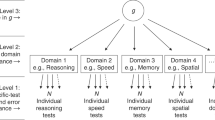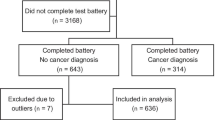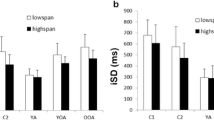Abstract
Individual differences in inspection time explain about 20% of IQ test variance. To determine whether the association between inspection time and IQ is mediated by common genes or by a common environmental factor, inspection time and IQ were assessed in an extended twin design. Data from 688 participants from 271 families were collected as part of a large ongoing project on the genetics of adult brain function and cognition. The sample consisted of a young adult cohort (mean age 26.2 years) and an older adult cohort (mean age 50.4 years). IQ was assessed with the Dutch version of the WAIS-3R. Inspection time was measured in the so-called Π-paradigm, in which a subject is asked to decide which leg of the Π-figure is longest at varying display times of the Π-figure. The number of correct inspections per second (i.e., the reciprocal of inspection time) was used to index perceptual speed. For Verbal IQ and Performance IQ, heritabilities were 85% and 69%, respectively. For perceptual speed, 46% of the total variance was explained by genetic variance. No differences in heritability estimates across age cohorts or sexes were found. Across the whole sample, a significant phenotypic correlation was found between perceptual speed and Verbal IQ (0.19) and between perceptual speed and Performance IQ (0.27). These correlations were entirely due to a common genetic factor that accounted for 10% of the genetic variance in verbal IQ and for 22% of the genetic variance in performance IQ. This factor is hypothesized to reflect the influence of genetic factors that determine axonal myelination in the central nervous system.
Similar content being viewed by others
REFERENCES
Anderson, T. J., Klugmann, M., Thomson, C. E., Schneider, A., Readhead, C., Nave, K. A., and Griffiths, I. R. (1999). Distinct phenotypes associated with increasing dosage of the PLP gene:implications for CMT1A due to PMP22 gene duplication. Ann. NY Acad. Sci. 14: 234–246.
Baaré, W. F. C., Hulshoff-Pol, H. E., Boomsma, D. I., Posthuma, D., de Geus, E. J. C., Schnack H. G., van Haren N. E. M., van Oel C. J., and Kahn R. S. (in press). Genetic and environmental individual differences in human brain morphology. Cereb. Cort.
Bartsch, U. (1996). Myelination and axonal regeneration in the central nervous system of mice deficient in the myelin-associated glycoprotein. J Neurocytol. 25: 303–313.
Boison, D., and Stoffel, W. (1994). Disruption of the compacted myelin sheath of axons of the central nervous system in proteolipid protein-deficient mice. Proc. Natl. Acad. Sci. USA 91(24): 11709–11713.
Boomsma, D. I. (1998). Twin registers in Europe: An overview. Twin Res. 1(1): 34–51.
Bouchard, Jr. T. J., and McGue, M. (1981). Familial studies of intelligence: A review. Science 212: 1055–1059.
Caldwell, J. H., Schaller, K. L., Lasher, R. S., Peles, E., and Levinson, S. R. (2000). Sodium channel Na(v)1.6 is localized at nodes of ranvier, dendrites, and synapses. Proc. Natl. Acad. Sci. USA 97(10): 5616–5620.
CBS (2000). Centraal Bureau voor de Statistiek, Voorburg /Heerlen.
Celesia, G. G. (1993). Visual evoked potentials and electroretinograms. In Electroencephalography. Basic principles, clinical applications, and related fields. Niedermeyer, E. and Lopes da Silva, F. (eds.), Baltimore, Williams and Wilkins, pp. 911–936.
Courchesne, E., Chisum, H. J., Townsend, J., Cowles, A., Covington, J., Egaas, B., Harwood, M., Hinds, S., and Press, G. A. (2000). Normal brain development and aging: Quantitative analysis at in vivo MR imaging in healthy volunteers. Radiology 216: 672–682.
Deary, I. J., and Stough, C. (1996). Intelligence and inspection time: Achievements, prospects, and problems. Am. Psycholog. 51: 599–608.
Detterman, D. K. (1994). Intelligence and the brain. In The neuropsychology of individual differences. P. A. Vernon (ed.), London, Acadamic Press, pp.
Evans, G., and Nettelbeck, T. (1993). Inspection time: A flash mask to reduce apparent movement effects. Pers. Indiv. Diff. 15: 91–94.
Eysenck, H. J. (1995). Can we study intelligence using the experimental method? Intelligence 20(3): 217–228.
Findlay, J. M. (1978). Estimates on probability functions: A more virulent PEST. Percep. Psychophys. 23: 181–185.
Flint, J. (1999). The genetic basis of cognition. Brain 122: 2015–2031.
Fujita, N., Kemper, A., Dupree, J., Nakayasu, H., Bartsch, U., Schachner, M., Maeda, N., Suzuki, K., and Popko, B. (1998). The cytoplasmic domain of the large myelin-associated glycoprotein isoform is needed for proper CNS but not peripheral nervous system myelination. J. Neurosci. 15(6): 1970–1978.
Griffiths, I. R., Klugmann, M., Anderson, T. J., Thomson, C. E., Vouyiouklis, D. A., and Nave, K. A. (1998). Current concepts of PLP and its role in the nervous system. Microsc. Res. Tech. 141: 344–358.
Griffiths, I. R., Montague, P., and Dickinson, P. (1995). The proteolipid protein gene. Neuropathol. Appl. Neurobiol. 21: 85–96.
Ikenaka, K., and Kagawa, T. (1995). Transgenic systems in studying myelin gene expression. Dev. Neurosci. 17: 127–136.
ISCED (1997, January). UNESCO, International Standard Classification of Education. (Rev. Ver. III). Geneve.
Jensen, A. R. (1993). Spearman' g: Links between psychometrics and biology. Ann. NY Acad. Sci. 702: 103–129.
Kandel, E. R., Siegelbaum, S. A., and Schwartz, J. H. (1991). Synaptic transmission. In E. R. Kandel, J. H. Schwartz, and T. M. Jessel (eds.), Principles of neural science, New Jersey: Prentice Hall, pp. 123–134.
Knapp, P. E. (1996). Proteolipid protein: Is it more than just a structural component of myelin? Dev. Neurosci. 18: 297–308.
Knibb, K. (1992). A dynamic mask for inspection time. Person. Individ. Diff. 13: 237–248.
Kranzler, J. K., and Jensen, A. R. (1989). Inspection time and intelligence: A meta-analysis. Intelligence 13: 329–347.
Lamme, V. A., and Roelfsema, P. R. (2000). The distinct modes of vision offered by feedforward and recurrent processing. Trends Neurosci. 23: 571–579.
Lemke, G. (1993). The molecular genetics of myelination: an update. Glia 7: 263–271.
Luciano, M., Smith, G. A., Wright, M. J., Geffen, G. M., Geffen, L. B., and Martin, N. G. (in press). On the heritability of inspection time and its covariance with IQ: A twin study. Intelligence.
Neale, M. C. (1997). Mx: Statistical modeling. (3rd ed). Box 980126 MCV, Richmond, VA 23298.
Neale, M. C., and Cardon, L. R. (1992). Methodology for genetic studies of twins and families (Vol. 67) NATO ASI Series. Series D., Behavioral and Social Sciences, Dordrecht, The Netherlands.
Nettelbeck, T. (1987). Inspection time and intelligence. In Vernon, P. A. (ed.), Speed of information processing and Intelligence, New Jersey, Ablex, pp. 295–346.
Pentland, A. (1980). Maximum likelihood estimation: The best PEST. Percep. Psychophys. 28: 377–379.
Posthuma, D., and Boomsma, D. I. (2000). A note on the statistical power in extended twin designs. Behav. Gen. 30: 147–158.
Posthuma, D., de Geus, E. J. C., Neale, M. C., Hulshoff Pol, H. E., Baaré, W. F. C., Kahn, R. S., and Boomsma, D. I. (2000). Multivariate genetic analysis of brain structure in an extended twin design. Behav. Gen. 30: 311–319.
Salin, P. A., and Bullier, J. (1995). Corticocortical connections in the visual system: Structure and function. Physiol. Rev. 75: 107–154.
Sheikh, K. A., Sun, J., Liu, Y., Kawai, H., Crawford, T. O., Proia, R. L., Griffin, J. W., and Schnaar, R. L. (1999). Mice lacking complex gangliosides develop Wallerian degeneration and myelination defects. Proc. Natl. Acad. Sci. USA 96(13): 7532–7537.
Smith, G. A., Luciano, M., Geffen, G. A., Geffen, L. B., Wright, M. J., and Martin, N. G. (2000). A twin study of psychometric intelligence and efficiency of information processing. Behav. Gen. 30: 419.
Standaard Onderwijs Indeling (SOI). (1998). Centraal Bureau voor Statistiek, Voorburg, Heerlen, The Netherlands, editie 1998–1999.
Stankov, L., and Roberts, M. D. (1997). Mental speed is not the ‘basic’ process of intelligence. Person. Individ. Diff. 22: 69–84.
Stoffel, W., and Bosio, A. (1997). Myelin glycolipids and their functions. Curr. Opin. Neurobiol. 7(5): 654–661.
Tessier-Lavigne, M. (1991). Phototransduction and information processing in the retina. In E. R. Kandel, J. H. Schwartz, and T. M. Jessel (Eds.). Principles of Neural Science. New Jersey: Prentice Hall, pp. 400–419.
Vickers, D., and Smith, P. (1986). The rationale for the inspection time index. Person. Individ. Diff. 7: 609–624.
WAIS-IIIR Manual. (1997). Dutch version. Lisse: Swets and Zeitlinger.
Weber, P., Bartsch, U., Rasband, M. N., Czaniera, R., Lang, Y., Bluethmann, H., Margolis, R. U., Levinson, S. R., Shrager, P., Montag, D., and Schachner, M. (1999). Mice deficient for tenascin-R display alterations of the extracellular matrix and decreased axonal conduction velocities in the CNS. J. Neurosci. 19: 4245–4262.
Woodward, K., and Malcolm, S. (1999). Proteolipid protein gene: Pelizaeus-Merzbacher disease in humans and neurodegeneration in mice. Trends Genet. 15(4): 125–128.
Wright, M. J., Boomsma, D. I., de Geus, E. J. C., Posthuma, D., van Baal, G. C. M., Luciano, M., Hansell, N. K., Ando, J., Hasegawa, T., Hiraishi, K., Ono, Y., Miyake, A., Smith, G. A., Geffen, G. A., Geffen, L. B., and Martin, N. G. (2001). Genetics of cognition: Outline of collaborative twin study. Twin Res. 4: 48–56.
Author information
Authors and Affiliations
Rights and permissions
About this article
Cite this article
Posthuma, D., de Geus, E.J.C. & Boomsma, D.I. Perceptual Speed and IQ Are Associated Through Common Genetic Factors. Behav Genet 31, 593–602 (2001). https://doi.org/10.1023/A:1013349512683
Issue Date:
DOI: https://doi.org/10.1023/A:1013349512683




